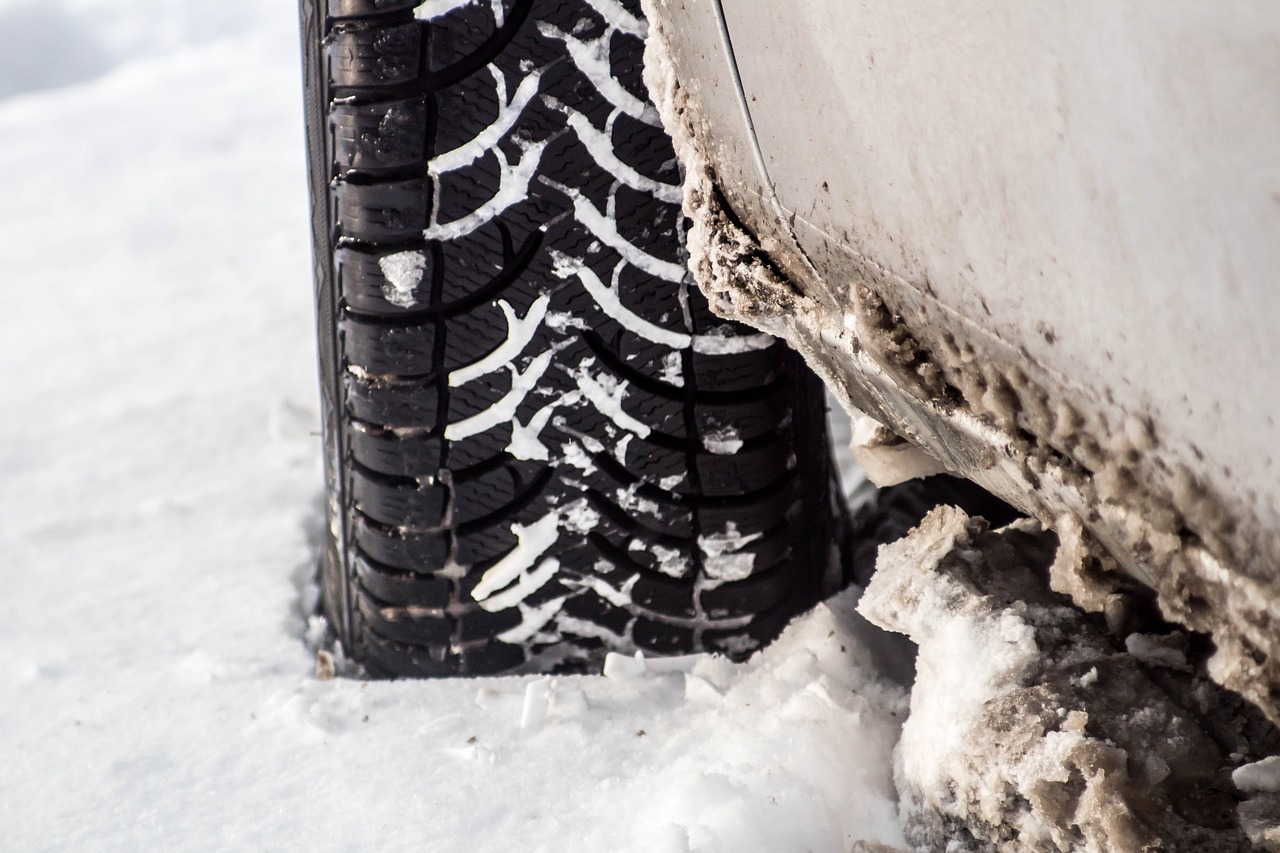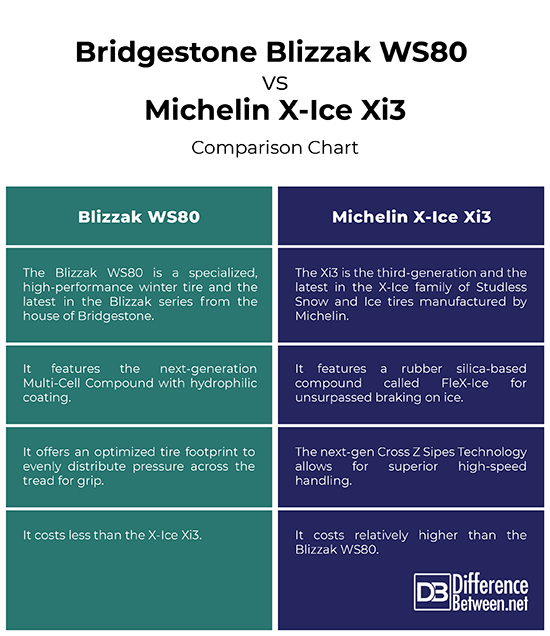Difference Between Blizzak WS80 and Michelin X-Ice Xi3
The Bridgestone Blizzak WS80 and Michelin X-Ice Xi3 are the two best winter tires that deliver much better snow and ice traction than the best all-season tires can muster. These are the best winter performance tires for those who don’t want to sacrifice their vehicle’s handling performance on dry surfaces, yet want superior traction in snow and ice. This is what specialized tires are for – to allow the tires to grip the road better to help you maintain grip and control in severe snowy or icy conditions. These are not like the usual one-size-fits-all; in fact, they are specially designed to get water away from under the wheel. All-season tires tend to lose their grip as the temperature starts dropping. That being said, Blizzak WS80 and X-Ice Xi3 are some of the best performance winter tires that are specially designed to take on colder temperatures, ice and snow, providing the best on-road traction on widest range of winter road surfaces. Both perform really well in extreme temperature changes but which one is the best?

What is Bridgestone Blizzak WS80?
The Blizzak WS80 is a specialized, high-performance winter tire from the house of Bridgestone and one of the most preferred choices for divers looking to conquer the toughest of winter conditions with superior control. It uses the Bridgestone’s next-generation adaptive NanoPro-Tech Multicell compound to create millions of little suction cups in the top half of the tread blocks that actually adhere to ice-covered roads. These modern Studless snow and ice tires are designed for increased winter traction and unmatched stopping ability and cornering. And the tread compound is more elastic which makes the tire more pliable in extreme freezing temperatures. The Blizzak name has been synonymous with superior winter traction and has been a go-to winter tire for drivers since 1993.

What is Michelin X-Ice Xi3?
The Michelin X-Ice Xi3 is the ideal ice and snow tire for sedans, coupes, SUVs, and crossovers, specially designed to provide the ultimate winter traction even in the harshest of winter conditions. The Xi3 is the third-generation of X-Ice family of specialized winter tires from the house of Michelin designed to perform. With the new Cross Z Sipes, which is a three-dimensional self-locking technology, the Xi3 provides a lasting winter performance while increasing the rigidity of the tires and their handling stability on the road. Similar to the Blizzak WS80, the Xi3 has tiny holes in the tread that vacuum that last tiny layer of water that forms between the tire and the road. With superior stopping ability, it stops up to 10 percent shorter on ice than other winter tires from leading manufacturers. Plus it allows for a longer tread life while delivering industry-leading energy efficiency.
Difference between Blizzak WS80 and Michelin X-Ice Xi3
-
Basics of Blizzak WS80 vs. Michelin X-Ice Xi3
– The Blizzak WS80 is a specialized, high-performance winter tire from the house of Bridgestone and one of the best ice and snow tires in the market. The Blizzak name has been synonymous with superior winter traction and has been a go-to winter tire for drivers since 1993. The Xi3 is the third-generation of X-Ice family of specialized winter tires from the house of Michelin designed to perform. The Xi3 is the ideal ice and snow tire for sedans, coupes, SUVs, and crossovers, specially designed to provide the ultimate winter traction even in the harshest of winter conditions.
-
Tread Pattern
– While both Xi3 and WS80 are objectively great tires for winter conditions with almost similar tread pattern, the Blizzak WS80 features an advanced tread pattern for ultimate snow/slush traction whereas the X-Ice Xi3 has better ice traction and wears longer. The WS80 features this specialized adaptive NanoPro-Tech Multicell compound which comprises of more than 50 percent of the tires’ tread depth, allowing for impressive control on ice and snow. The Xi3 has an intricate tread pattern featuring a new Cross Z Sipes Technology, which uses a three-dimensional design that locks the sipes in place, to provide ultimate stability and handling grip over snow-laden surfaces.
-
Stopping Power of Blizzak WS80 vs. Michelin X-Ice Xi3
– While both perform really well in the harshest of winter conditions, the X-Ice Xi3 is known for its exceptional snow traction and stopping power on ice which allows it to stop 10 percent shorter on ice than any other winter tire in the market. The Blizzak WS80 also delivers remarkable stopping power and handling because they stop 33 percent faster on ice than other winter tires in the segment, thanks to the next-generation Multi-Cell Compound with hydrophilic coating which draws water away to combat slippage and improve braking on ice.
Bridgestone Blizzak WS80 vs. Michelin X-Ice Xi3: Comparison Chart

Summary of Blizzak WS80 vs. Michelin X-Ice Xi3
Both Blizzak WS80 and Michelin X-Ice Xi3 are the best winter performance tires for those who don’t to sacrifice their vehicle’s handling performance on dry surfaces, yet want superior traction in snow and ice. However, the WS80 delivers remarkable stopping power and handling, thanks to its optimized tire footprint. The X-Ice Xi3 is also known for its exceptional snow traction and stopping power on ice while maintaining all the advantages of long wear, performance, and safety. If price is not the factor, then the Xi3 is the preferred choice which lasts for many winters. Bridgestone still remains the top choice of drivers who don’t want to sacrifice handling yet want exceptional traction on ice and snow.
- Difference Between Caucus and Primary - June 18, 2024
- Difference Between PPO and POS - May 30, 2024
- Difference Between RFID and NFC - May 28, 2024
Search DifferenceBetween.net :
Leave a Response
References :
[0]Image credit: https://www.maxpixel.net/Way-Winter-Tire-Snow-Zaspa-Car-Frost-Wet-Snow-3915847
[1]Image credit: https://commons.wikimedia.org/wiki/File:2017-10-31_(789)_Bridgestone_Blizzak_LM-25_205-55_R_16_91_H_tire_at_Bahnhof_Prinzersdorf.jpg
[2]Gilles, Tim. Automotive Chassis: Brakes, Suspension and Steering. Boston, Massachusetts: Cengage, 2005. Print
[3]Heißing, Bernhard and Metin Ersoy. Chassis Handbook. Berlin: Springer, 2010. Print
